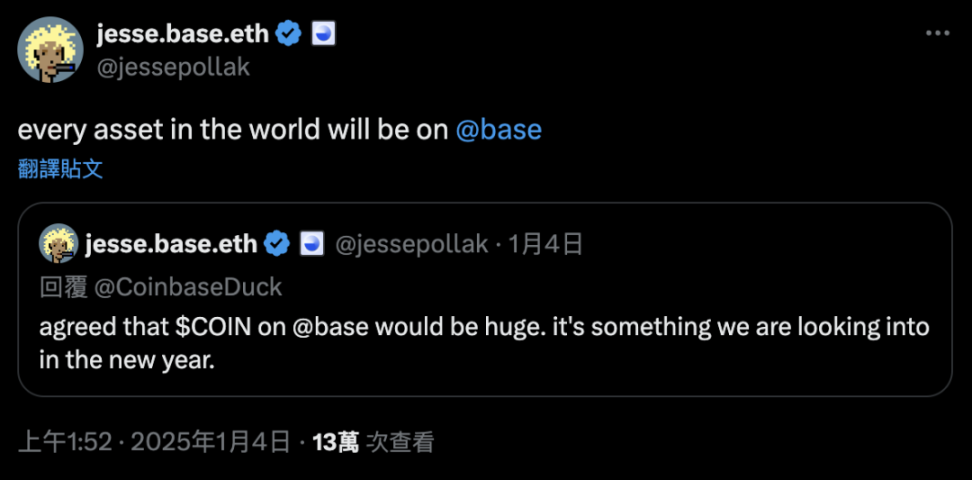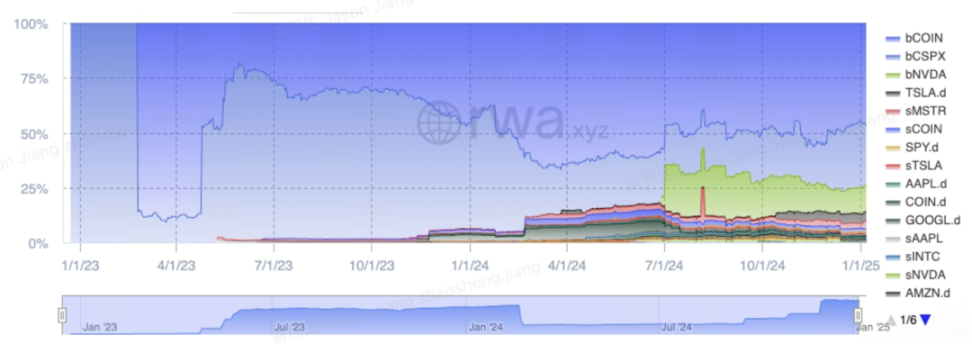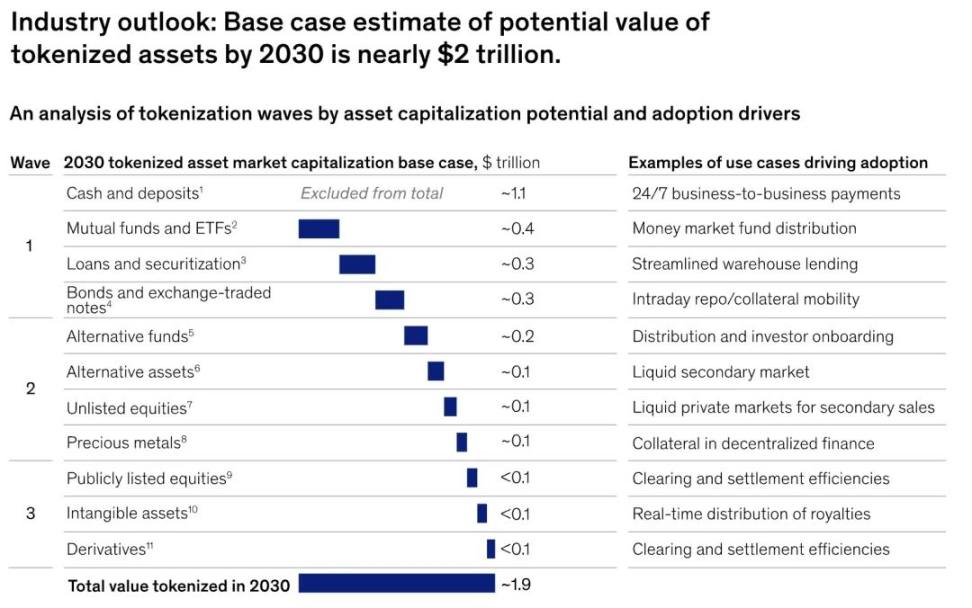Old money seeking new ideas: Wall Street accelerates its move to the blockchain

Reprinted from panewslab
01/10/2025·1MAuthor: Jason Jiang, OKG Research

From Bitcoin spot ETFs to the wave of tokenization, the institutional power represented by Wall Street is profoundly affecting and changing the direction of the crypto market, and we believe that this power will become more powerful in 2025. To this end, OKG Research has launched a series of studies called "#chainWall Street" to continue to pay attention to the innovation and practice of traditional institutions in the field of Web3. How do top institutions such as BlackRock and JPMorgan Chase embrace innovation? How will tokenized assets, on-chain payments and decentralized finance shape the future financial landscape?
This article is the first in a series of studies on "#chainWall Street".
When predicting the crypto market in 2025, investment management firm VanEck boldly predicted that Coinbase would "take the unprecedented step of tokenizing its shares and deploying them on its Base blockchain." The prophecy seems to be coming true: Jesse Pollak, the main developer of the Base chain, recently revealed that providing $Coin on the Base chain is "something we are studying in the new year" and expects that "every asset in the world will eventually be in Base on".
We don’t yet know whether Coinbase can realize its plan, but as it uses its own stocks as a starting point for tokenization exploration, Wall Street is also accelerating “Onchain”.

Wall Street begins to migrate to the chain
From 2024 to now, the encryption market has experienced rapid growth, and the boundaries of innovation have continued to expand. The core driving force behind this comes from the cryptocurrency spot ETF promoted by Wall Street institutions represented by BlackRock. Today, these institutions are turning more attention to the area of tokenization.
BlackRock CEO Larry Fink said that while the approval of crypto spot ETFs is important, these are "stepping stones" towards wider tokenization of other assets. Riding on the tokenization boom, Wall Street is pushing for more assets and businesses to be put on the chain, allowing traditional finance and crypto innovation to collide in the digital space.
Although tokenization of financial assets has been happening since 2017, it has only recently taken off like crazy. Unlike early exploration that focused on permissioned chains, more and more tokenization practices are converging on public chains, and Ethereum has become the first choice for institutional tokenization. These institutions no longer reject decentralization, but instead actively explore the radius of crypto influence, trying to provide new experiences through the recombination of assets and technology. As Coinbase said, "Web3" is gradually being replaced by the more appropriate "Onchain".
Only this time, the protagonists are no longer just cryptocurrencies, but also many assets from the physical world, such as stocks. As the largest cryptocurrency exchange in the United States, Coinbase is the most popular stock in the tokenization market at this stage. rwa.xyz data shows that as of January 2025, the total market value of tokenized stocks was approximately US$12.55 million, of which nearly 50% were tokenized stocks with Coinbase as the target. In addition, stock tokens such as Nvidia, Tesla and Apple among the seven largest American technology stocks also frequently appear on the chain.

Figure market structure for tokenized stocks
Coinbase plans to tokenize its stocks and issue them on the Base chain, which will not only allow investors to trade their stocks directly on the chain, but also further integrate the trading platform, the Base chain and the on-chain asset ecology, and explore ways to create compliant and trustworthy assets in the United States. The implemented stock tokenization model keeps it ahead in the competition of crypto-financial innovation.
This layout must not be just for $COIN tokenization. Perhaps as Jesse Pollak said, they hope that all assets in the world will be on the Base chain. But in comparison, a more foreseeable future is to accelerate the migration of major global assets to the chain through tokenization.
Although tokenization, like other innovative concepts, has been met with skepticism, the idea centered on democratizing access to investment opportunities and simplifying the efficiency of capital flow has taken root. The on-chain usability demonstrated by stablecoins, BUIDL funds and other tokenized assets has proven its worth, and more and more asset classes are migrating on-chain: not only the usual private credit, bonds, funds and gold; There are assets such as agricultural products, carbon points, and rare minerals.
According to the forecast of the Ouke Cloud Chain Research Institute, in 2025 we will see Wall Street continue to "Onchain" frequently and promote a richer and more mature tokenization system: not only the scale of tokenized assets on the chain of non-stable coins will exceed at least 30 billion US dollar, we will also see more companies, led by Wall Street, enter the field of tokenization and bring more valuable assets to the chain. While the scale of tokenization of these assets may not be “exaggerated,” it is still significant.
Towards a more democratic future of finance
60 years ago, when you purchased a financial security or used it as collateral, you might have to wait 5 days to receive a paper voucher to confirm the transaction. Later, the number of paper vouchers increased and transaction settlement became unmanageable, forcing Wall Street to start Try using a computer to track securities.
Today, gaining a competitive trading advantage from better or faster technology is a ubiquitous part of modern finance. Whether it is BlackRock and Goldman Sachs, Citigroup and JPMorgan Chase, almost everyone on Wall Street believes that tokenization is the future trend and is embracing the changes brought about by tokenization. Compared with the passivity of financial informatization, tokenization is the next step of change that finance actively embraces.
In this revolution, deploying assets to the chain through tokenization is no longer a problem. The challenge in the future is how to increase the demand for tokenized assets and thereby solve the liquidity problem on the chain. The unparalleled success of traditional securities is largely due to their high liquidity and low transaction costs. If tokenized assets are simply locked on the chain or can only be found in secondary markets with limited liquidity, their actual value will also be Very limited.
Nadine Chakar, who once managed the digital assets department of State Street Bank in the United States, once expressed a similar view, "The bank cooperates with a company, issues tokenized bonds, and then issues a press release. What will happen next? Nothing will happen. . These bonds are like rocks and difficult to circulate in the market.”
How to solve the liquidity problem of tokenized markets? Different institutions may have different plans, but in my opinion the most direct way is to accelerate the tokenization of high-quality assets. Only by accumulating enough high-quality assets on the chain can we attract more users and funds to migrate to the chain, thereby solving the liquidity problem.

McKinsey predicts tokenization will approach $2 trillion by 2030
Tokenization is now moving from pilots to large-scale deployment as network effects increase. However, as McKinsey predicts, tokenization cannot happen overnight, and there will be significant time lags in the tokenization process of different assets: the first wave will be driven by use cases with proven return on investment and existing scale, followed by Use cases for asset classes where the current market is smaller, the benefits are less obvious, or where tougher technical challenges need to be solved.
When the first wave of on-chain assets explores compliant and practical business models and brings sufficient attention and liquidity to the on-chain market, perhaps tokenization will create a more free and democratic "shadow" capital market in the future. . Giving investors freer investment opportunities and allowing more companies to complete financing more conveniently, tokenization will bring profound changes to both asset supply and demand sides, and gradually eliminate the barriers between the off-chain and on-chain worlds, forming a truly global New financial ecology.


 jinse
jinse